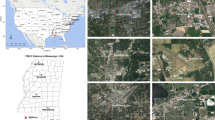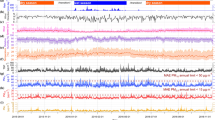Abstract
The temporal and spatial trends in the variability of PM10 and PM2.5 from 2010 to 2015 in the metropolitan area of Lima-Callao, Peru, are studied and interpreted in this work. The mean annual concentrations of PM10 and PM2.5 have ranges (averages) of 133–45 μg m−3 (84 μg m−3) and 35–16 μg m−3 (26 μg m−3) for the monitoring sites under study. In general, the highest annual concentrations are observed in the eastern part of the city, which is a result of the pattern of persistent local winds entering from the coast in a south-southwest direction. Seasonal fluctuations in the particulate matter (PM) concentrations are observed; these can be explained by subsidence thermal inversion. There is also a daytime pattern that corresponds to the peak traffic of a total of 9 million trips a day. The PM2.5 value is approximately 40% of the PM10 value. This proportion can be explained by PM10 re-suspension due to weather conditions. The long-term trends based on the Theil-Sen estimator reveal decreasing PM10 concentrations on the order of −4.3 and −5.3% year−1 at two stations. For the other stations, no significant trend is observed. The metropolitan area of Lima-Callao is ranked 12th and 16th in terms of PM10 and PM2.5, respectively, out of 39 megacities. The annual World Health Organization thresholds and national air quality standards are exceeded. A large fraction of the Lima population is exposed to PM concentrations that exceed protection thresholds. Hence, the development of pollution control and reduction measures is paramount.





Similar content being viewed by others
References
Arellano Rojas, C. S. (2013). Meteorological conditions and pollution levels in the metropolitan region of Lima - Peru (in Portuguese). Master Thesis. Institute of Astronomy, Geophysics and Atmospheric Sciences, Universidade de São Paulo, São Paulo, Brazil. [WWW Document]. URL https://goo.gl/qw9BOv (accessed 3.8.17).
Awe, Y., Nygard, J., Larssen, S., Lee, H., Dulal, H., Kanakia, R., (2015). Clean air and healthy lungs: enhancing the World Bank’s approach to air quality management (No. No3), Environment and natural resources global practice discussion paper. Washington, DC.
Baklanov, A., Molina, L. T., & Gauss, M. (2016). Megacities, air quality and climate. Atmospheric Environment, 126, 235–249. https://doi.org/10.1016/j.atmosenv.2015.11.059.
Baldasano, J., Valera, E., & Jimenez, P. (2003). Air quality data from large cities. Sci. Total Environ., 307, 141–165. https://doi.org/10.1016/S0048-9697(02)00537-5.
Bell, M. L. L., Davis, D. L. L., Gouveia, N., Borja-Aburto, V. H. H., & Cifuentes, L. A. A. (2006). The avoidable health effects of air pollution in three Latin American cities: Santiago, São Paulo, and Mexico City. Environmental Research, 100, 431–440. https://doi.org/10.1016/j.envres.2005.08.002.
Bernardoni, V., Vecchi, R., Valli, G., Piazzalunga, A., & Fermo, P. (2011). PM10 source apportionment in Milan (Italy) using time-resolved data. Sci. Total Environ., 409, 4788–4795. https://doi.org/10.1016/j.scitotenv.2011.07.048.
Carbajal-Arroyo, L., Barraza-Villarreal, A., Durand-Pardo, R., Moreno-Macías, H., Espinoza-Laín, R., Chiarella-Ortigosa, P., & Romieu, I. (2007). Impact of traffic flow on the asthma prevalence among school children in lima, Peru. The Journal of Asthma, 44, 197–202. https://doi.org/10.1080/02770900701209756.
Carslaw, D. C. (2013). The openair manual—open-source tools for analysing air pollution data. Manual for version 0.9–0, King’s College London. London, UK. [WWW Document]. URL https://goo.gl/iigCI9 (accessed 3.8.17).
Carslaw, D. C., & Ropkins, K. (2012). Openair—an R package for air quality data analysis. Environ. Model. Softw., 27–28, 52–61. https://doi.org/10.1016/j.envsoft.2011.09.008.
CIAL. (2010). Second Integral Plan of Atmospheric Sanitation for Lima-Callao 2011–2015 (in spanish). Management Committee Clean Air Initiative (IAL) Lima-Callao, Lima, Peru. [WWW Document]. URL https://goo.gl/O9eaB3.
Dawidowski, L., Sánchez-Ccoyllo, O., Alarcón, N.. (2014). Estimation of vehicular emissions in Metropolitan Lima. Final report (in Spanish). Lima, Peru: Servicio Nacional de Meteorología e Hidrología del Perú (SENAMHI). Report within the framework of the project South American Emissions, Megacities and Climate.
DeGaetano, A. T., & Doherty, O. M. (2004). Temporal, spatial and meteorological variations in hourly PM2.5 concentration extremes in new York City. Atmospheric Environment, 38, 1547–1558. https://doi.org/10.1016/j.atmosenv.2003.12.020.
EPA-US. (2009). Integrated Science Assessment (ISA) for Particulate Matter (PM). U.S. Environmental Protection Agency, Washington, DC, USA. EPA/600/R-08/139F. [WWW Document]. URL https://goo.gl/PCnvbj (accessed 3.13.17).
EPA-US, 2013. National Ambient Air Quality Standards for Particulate Matter; Final Rule. 78 Federal Register 3086 (Document No2012–30946), Office of Air Quality Planning and Standards, United States Environmental Protection Agency, Research Triangle Park, NC, USA. [WWW Document]. URL https://goo.gl/3KB3SX.
IGN. (2014). National Geographic Institute, Republic of Peru [WWW Document]. URL http://www.ign.gob.pe (accessed 3.13.17).
Jelić, D., Bencetić, Z. (2010). Air quality in Rijeka, Croatia 27.
Konstantinos, M. (2008). Quantification and evaluation of dust resuspension pm10 emissions in two large urban centers in Greece Quantifica, 543–547.
Lelieveld, J., Evans, J. S., Fnais, M., Giannadaki, D., & Pozzer, A. (2015). The contribution of outdoor air pollution sources to premature mortality on a global scale. Nature, 525, 367–371.
LR. (2010). Senamhi inaugurates First Air Quality Monitoring Station in Ate | News from Peru | [WWW Document]. TheRepublica.pe. URL https://goo.gl/5k3qc8 (accessed 3.14.17).
Molina, L. T., & Molina, M. J. (2002). Air quality impacts: local and global concern. In L. T. Molina & M. J. Molina (Eds.), Air quality in the Mexico megacity: an integrated assessment (pp. 1–19). Dordrecht: Springer Netherlands. https://doi.org/10.1007/978-94-010-0454-1_1.
Molina, M. J. J., & Molina, L. T. T. (2004). Megacities and atmospheric pollution. Journal of the Air & Waste Management Association (1995), 54, 644–680.
Molina, C., Toro A. R., Morales, S. R. G. E., Manzano, C., Leiva-Guzmán, M. A. (2017). Particulate matter in urban areas of south-central Chile exceeds air quality standards. Air Qual. Atmos. {&} Heal. 1–15. doi:https://doi.org/10.1007/s11869-017-0459-y.
MTC. (2016). Estimated National Vehicle Park, according to Department: 2007–2016. Lima, Peru.
PE-MINAM. (2001). Supreme Decree No. 074–2001-PCM Regulation of National Environmental AIr Quality Standards (in spanish), Ministry of the Environment (MINAM), Republic of Peru. [WWW Document]. doi:D.S No 074–2001 –PCM.
PE-MINAM. (2014). National air quality report 2013–2014 (in spanish). Ministry of the Environment (MINAM), Republic of Peru. [WWW Document]. URL https://goo.gl/czqcNg (accessed 3.15.14).
Reich, S., Robledo, F., Gomez, D., & Smichowski, P. (2008). Air pollution sources of PM10 in Buenos Aires City. Environmental Monitoring and Assessment, 155, 191. https://doi.org/10.1007/s10661-008-0428-x.
RStudio. (2016). RStudio: Integrated development environment for R [Computer software].
Sen, P. K. (1968). Estimates of the regression coefficient based on Kendall’s tau. Journal of the American Statistical Association, 63, 1379–1389. https://doi.org/10.2307/2285891.
SENAMHI. (2014). Estimation of vehicular emissions in Metropolitan Lima - Final report (in spanish). National Service of Meteorology and Hydrology of Peru (SENAMHI), Ministry of the Environment (MINAM), Republic of Perú. [WWW Document]. Natl. Serv. Meteorol. Hydrol. Peru (SENAMHI), Minist. Environ. (MINAM), Repub. Perú.
SENAMHI. (2016). Air quality assessment in Lima metropolitan area 2015 (in spanish). National Service of Meteorology and Hydrology of Peru (SENAMHI), Ministry of the Environment (MINAM), Republic of Peru. [WWW Document]. URL https://goo.gl/db2JgU (accessed 3.8.17).
Stanek, L. W., Brown, J. S., Stanek, J., Gift, J., & Costa, D. L. (2011). Air pollution toxicology—a brief review of the role of the science in shaping the current understanding of air pollution health risks. Toxicological Sciences, 120, S8–S27.
Tager, I. (2012). Health Effects of Aerosols. In Aerosols Handbook (pp. 565–636). CRC Press. doi:https://doi.org/10.1201/b12668-24.
Theil, H. (1992). A rank-invariant method of linear and polynomial regression analysis. In B. Raj & J. Koerts (Eds.), Henri Theil’s contributions to economics and econometrics: Econometric theory and methodology (pp. 345–381). Dordrecht: Springer Netherlands. https://doi.org/10.1007/978-94-011-2546-8_20.
Toro, A. R., Morales, S. R. G. E., Canales, M., Gonzalez-Rojas, C., & Leiva, G. M. A. A. (2014). Inhaled and inspired particulates in metropolitan Santiago Chile exceed air quality standards. Building and Environment, 79, 115–123. https://doi.org/10.1016/j.buildenv.2014.05.004.
Toro, A. R., Córdova, J. A., Canales, M., Morales, S. R. G. E., Mardones, P. P., Leiva, G. M. A., 2015. Trends and threshold exceedances analysis of airborne pollen concentrations in Metropolitan Santiago Chile. PLoS One 10. doi:https://doi.org/10.1371/journal.pone.0123077.
UN. (2016). The World’s Cities in 2016 – Data Booklet (ST/ESA/ SER.A/392). United Nations, Department of Economic and Social A airs, Population Division, New York, NY, USA. [WWW Document]. URL https://goo.gl/pVdtwy (accessed 3.8.17).
Underhill, L., Bose, S., Williams, D., Romero, K., Malpartida, G., Breysse, P., Klasen, E., Combe, J., Checkley, W., & Hansel, N. (2015). Association of Roadway Proximity with indoor air pollution in a Peri-Urban Community in lima, Peru. International Journal of Environmental Research and Public Health, 12, 13466–13481. https://doi.org/10.3390/ijerph121013466.
Vahlsing, C., & Smith, K. R. (2012). Global review of national ambient air quality standards for PM(10) and SO(2) (24 h). Air Quality, Atmosphere and Health, 5, 393–399. https://doi.org/10.1007/s11869-010-0131-2.
Valavanidis, A., Vlachogianni, T., Fiotakis, K., & Loridas, S. (2013). Pulmonary oxidative stress, inflammation and cancer: Respirable particulate matter, fibrous dusts and ozone as major causes of lung carcinogenesis through reactive oxygen species mechanisms. International Journal of Environmental Research and Public Health, 10, 3886–3907. https://doi.org/10.3390/ijerph10093886.
WB. (2017). GDP Online Database. World Bank, Washington, DC, USA. [WWW Document]. URL https://goo.gl/Bgn2X (accessed 3.13.17).
WHO. (2006). Air quality guidelines. Global update 2005. Particulate matter, ozone, nitrogen dioxide and sulfur dioxide. World Health Organization Copenhagen, Denmark. [WWW Document]. URL https://goo.gl/hz79bI (accessed 1.23.15).
WHO. (2016a). Fact sheet: Ambient (outdoor) air quality and health. World Health Organization, Media Centre, Copenhagen, Denmark. [WWW Document]. URL https://goo.gl/iJomX (accessed 1.23.15).
WHO. (2016b). Ambient (outdoor) air pollution database, by country and city (xlsx file). World Health Organization (WHO), Department of Public Health, Environmental and Social Determinants of Health. Geneva, Switzerland. [WWW Document]. URL https://goo.gl/nPsdIq (accessed 3.8.17).
Xu, G., Jiao, L., Zhang, B., Zhao, S., Yuan, M., Gu, Y., Liu, J., & Tang, X. (2017). Spatial and temporal variability of the PM2.5/PM10 ratio in Wuhan, Central China. Aerosol and Air Quality Research, 17, 741–751. https://doi.org/10.4209/aaqr.2016.09.0406.
Acknowledgments
We acknowledge the financial support of the National Meteorology and Hydrology Service of Peru–SENAMHI-Perú, for project SNIP N° 199842 “Expansion and Improvement of the Monitoring Network for the Forecasting of Air Quality in the Metropolitan Area of Lima” and Program 096—PPR096-Air Quality Management. MALG acknowledges the support of the National Commission for Scientific and Technological Research CONICYT/FONDECYT 2016 grant no. 1160617. RAT acknowledges the partial support of the National Commission for Scientific and Technological Research CONICYT/FONDECYT INICIACION 2015 grant no. 11150931. The funders had no role in the study design, data collection and analysis, and decision to publish or the preparation of the manuscript.
Author information
Authors and Affiliations
Corresponding author
Ethics declarations
Competing interests
The authors declared that they have no competing interests.
Electronic supplementary material
ESM 1
(DOCX 456 kb).
Rights and permissions
About this article
Cite this article
Silva, J., Rojas, J., Norabuena, M. et al. Particulate matter levels in a South American megacity: the metropolitan area of Lima-Callao, Peru. Environ Monit Assess 189, 635 (2017). https://doi.org/10.1007/s10661-017-6327-2
Received:
Accepted:
Published:
DOI: https://doi.org/10.1007/s10661-017-6327-2




